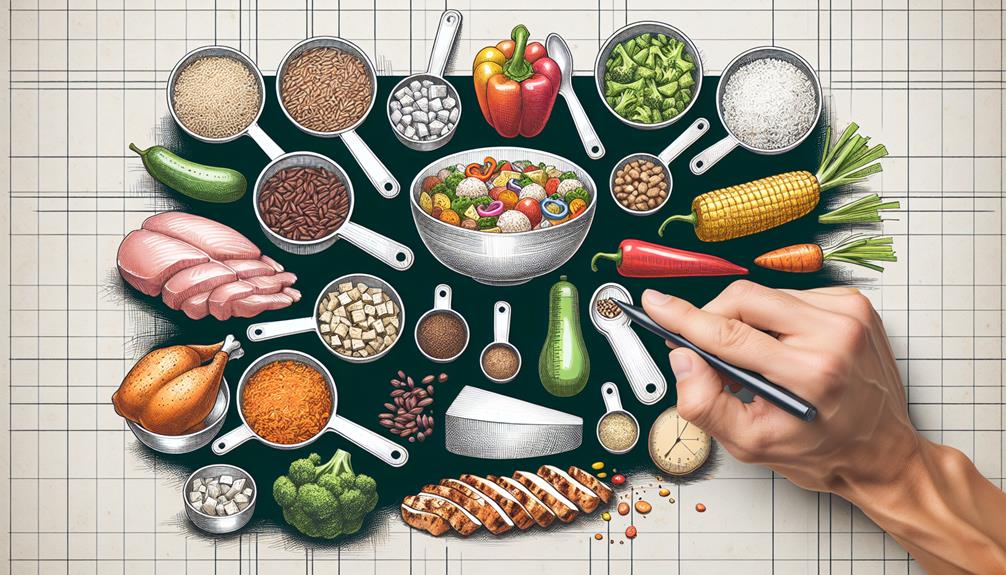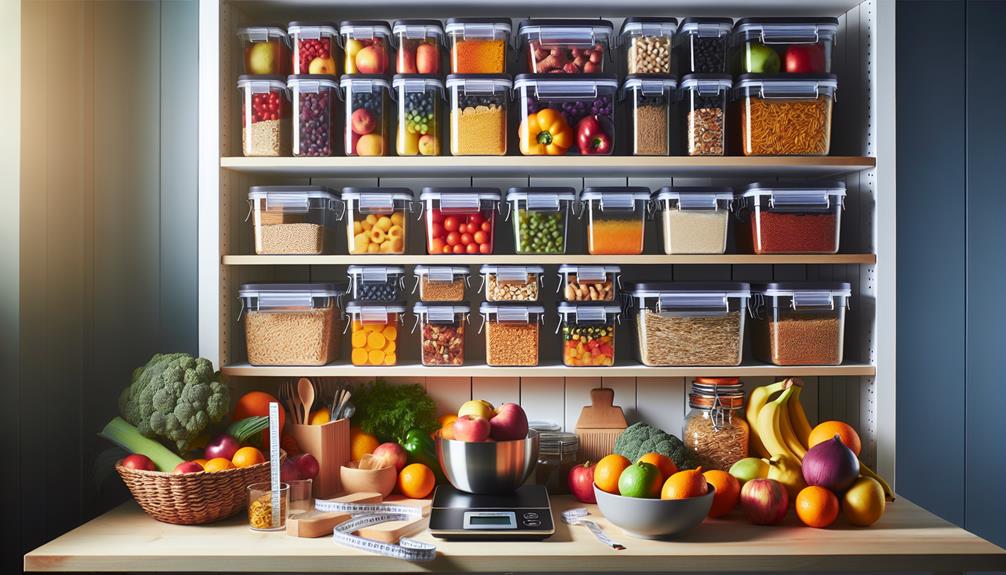Are you tired of constantly feeling deprived while trying to manage your calorie intake? It's time to discover the power of portion control. With a few simple techniques, you can enjoy your favorite foods without the guilt and still achieve your fitness goals. But how exactly can you do that? Well, in this discussion, we will explore the basics of portion control, the role of mindful eating, practical tips for measuring serving sizes, strategies for dining out, and even how to incorporate portion control into your daily routine. Get ready to regain control of your eating habits and embrace a healthier, more balanced lifestyle.
Key Takeaways
- Portion control is important for maintaining a healthy weight and preventing weight gain.
- Mindful eating can help develop healthier eating habits and make better choices regarding portion sizes.
- Visual cues, food scales, and reading food labels are useful tools for measuring and estimating serving sizes.
- Using smaller plates, filling half the plate with vegetables, and pre-portioning snacks can assist with portion control at home.
Understanding Portion Control Basics
To successfully manage your calorie intake without feeling deprived, it is crucial to understand the basics of portion control. Portion control refers to managing the amount of food you eat in a single sitting. By practicing portion control, you can enjoy the benefits of maintaining a healthy weight and preventing weight gain.
One of the key benefits of portion control is its impact on weight management. When you consume more calories than your body needs, the excess is stored as fat, leading to weight gain. By controlling your portion sizes, you can ensure that you are consuming an appropriate amount of calories for your body's needs. This can help you maintain a healthy weight or even lose weight if that is your goal.
Portion control also allows you to enjoy a variety of foods while still managing your calorie intake. Instead of completely eliminating certain foods from your diet, you can have smaller portions of them. This helps to prevent feelings of deprivation and increases the sustainability of your eating habits in the long run.
The Role of Mindful Eating in Portion Control
Mindful eating plays a crucial role in practicing portion control and managing your calorie intake effectively. By being mindful of what and how much you eat, you can develop healthier eating habits and make better choices when it comes to portion sizes.
One technique that can help with mindful eating is the use of a hunger and fullness scale. This scale helps you gauge your level of hunger before and after a meal, allowing you to eat when you're truly hungry and stop when you're comfortably full. By paying attention to your body's signals, you can avoid overeating and better control your portions.
Another technique is to slow down and savor your food. Taking the time to chew slowly and appreciate the flavors and textures of your meal can help you feel more satisfied with smaller portions. Additionally, practicing portion control has several benefits, including weight management, improved digestion, and better overall health.
How to Measure and Estimate Serving Sizes

Measuring and estimating serving sizes accurately is an important skill for managing your calorie intake and practicing portion control effectively. Estimating portions can be challenging, but there are several portion control tools that can help you gauge serving sizes more accurately.
One of the simplest ways to estimate serving sizes is by using visual cues. For example, a serving of meat should be about the size of a deck of cards, while a serving of pasta should be about the size of a tennis ball. By comparing your food to these familiar objects, you can get a rough estimate of the appropriate portion size.
Another helpful tool for measuring serving sizes is a food scale. This allows you to weigh your food and ensure that you are consuming the recommended portion size. It may take some practice to get used to weighing your food, but it can be a useful tool in managing your calorie intake.
Reading food labels is also important for estimating serving sizes. Pay attention to the serving size listed on the label and compare it to the amount you are actually consuming. This will help you determine if you are eating more or less than the recommended serving size.
Tips for Portion Control at Home
One effective strategy for managing portion control at home is to create a visually balanced plate with appropriate portion sizes. This not only helps you keep track of your calorie intake, but also ensures that you are getting a variety of nutrients in each meal. Here are some tips to help you practice portion control at home:
- Use smaller plates and bowls: By using smaller plates and bowls, you can trick your mind into thinking that you are eating more than you actually are. This can help you avoid overeating.
- Fill half of your plate with vegetables: Vegetables are low in calories and high in nutrients, making them the perfect food for portion control. By filling half of your plate with vegetables, you can naturally reduce the portion sizes of other high-calorie foods.
- Measure your ingredients: Using measuring cups and spoons can help you accurately portion your meals. This is especially important when cooking recipes that have specific serving sizes.
- Pre-portion snacks: Instead of eating straight from a bag or container, pre-portion your snacks into smaller containers or bags. This helps prevent mindless eating and ensures that you are not consuming more than you intended.
- Involve kids in portion control: Teach your children about portion control by involving them in meal planning and preparation. This can help them develop healthy eating habits from a young age.
Strategies for Portion Control When Dining Out

When dining out, it can be challenging to practice portion control and manage your calorie intake effectively. However, with a few smart strategies, you can still enjoy a meal at a restaurant without overdoing it on portion sizes.
One tip for portion control at fast food restaurants is to choose smaller-sized options. Many fast food chains offer smaller, "value" versions of their regular menu items. Opt for these instead of the super-sized options, which can pack in extra calories. Additionally, consider ordering from the kids' menu, as these meals are typically smaller and more appropriate for portion control.
For takeout meals, portion control can be a bit trickier since you don't have control over the serving sizes. One method is to divide your meal in half as soon as you receive it and save the other portion for later. This way, you can enjoy a reasonable portion size without feeling the need to eat it all in one sitting.
Another strategy is to order a side salad or a vegetable-based appetizer to help fill you up before your main course arrives. This can help prevent overeating and keep your portion sizes in check.
Portion Control for Snacks and Desserts
To continue managing your calorie intake effectively, mastering portion control for snacks and desserts is essential. Snacks and desserts are often high in calories and can easily sabotage your weight loss efforts. However, with a few simple strategies, you can still enjoy these treats while staying on track with your goals. Here are some tips for portion control when it comes to snacks and desserts:
- Use smaller plates and bowls: By using smaller dishes, you automatically reduce the portion size, making it easier to control your calorie intake.
- Pre-portion your snacks: Instead of eating straight from the bag or container, divide your snacks into single-serving portions. This helps prevent mindless overeating.
- Choose healthier snack options: Opt for snacks that are low in calories and high in nutrients, such as fresh fruits, vegetables, or Greek yogurt.
- Practice mindful eating: Take the time to savor each bite and pay attention to your body's hunger and fullness cues. This helps prevent overeating and promotes portion control.
- Plan ahead for busy lifestyles: Prepare healthy snack options in advance, such as pre-cut fruits and veggies or portioned-out nuts, so you're less likely to grab unhealthy options when you're on the go.
Incorporating Portion Control Into Your Daily Routine

Incorporating portion control into your daily routine is a key factor in maintaining a healthy weight and managing your calorie intake effectively. Whether your goal is weight loss or simply maintaining a healthy diet, portion control plays a vital role in achieving these objectives.
To incorporate portion control into your daily routine, start by being mindful of your portion sizes. Pay attention to the recommended serving sizes on food labels and use measuring cups or a food scale to ensure accuracy. It may take some time to adjust to smaller portions, but over time, your body will adapt.
Another helpful strategy is to use smaller plates and bowls. Research has shown that using smaller dishware can trick your brain into thinking you are consuming more food than you actually are. This can help you feel satisfied with smaller portions.
Additionally, it's important to listen to your body's hunger and fullness cues. Eat slowly and savor each bite, allowing your body time to register when it is satisfied. This can prevent overeating and promote portion control.
Lastly, plan your meals and snacks ahead of time. By pre-portioning your food and having healthy options readily available, you can avoid mindless snacking and make more intentional choices about what and how much you consume.
Incorporating portion control into your daily routine is a practical and effective strategy for managing your weight and maintaining a healthy diet. By being mindful of portion sizes, using smaller dishware, listening to your body's cues, and planning your meals and snacks, you can successfully incorporate portion control into your daily life.
Frequently Asked Questions
Can Portion Control Help With Weight Loss?
Portion control can be an effective strategy for weight loss. It helps manage calorie intake without feeling deprived. Benefits of portion control include better portion awareness and satisfaction. Successful strategies include using smaller plates, measuring food, and practicing mindful eating.
Is It Possible to Practice Portion Control Without Feeling Deprived?
Yes, it is possible to practice portion control without feeling deprived. By using portion control strategies and mindful eating techniques, you can still enjoy your favorite foods while managing your calorie intake effectively.
What Are Some Common Mistakes People Make When Estimating Serving Sizes?
When estimating serving sizes, common mistakes include eyeballing portions, not reading labels, and using oversized plates. To avoid these errors, try measuring portions, using smaller plates, and being mindful of portion distortion.
Are There Any Tips Specifically for Portion Control When Dining Out at Restaurants?
When dining out, you can still practice portion control. Try sharing a meal, ordering appetizers as your main course, or asking for a to-go box right away. These strategies can help you manage your calorie intake.
How Can Portion Control Be Incorporated Into a Busy Daily Routine?
To incorporate portion control into your busy daily routine, try these strategies: plan your meals in advance, use smaller plates and bowls, measure your food, and practice mindful eating. Preparing portion-controlled meals ahead of time can also be helpful.
Conclusion
Incorporating portion control into your daily routine is a practical and evidence-based approach to managing calories without deprivation. By understanding the basics of portion control, practicing mindful eating, and measuring serving sizes, you can take control of your calorie intake. Whether at home or dining out, these strategies can help you make healthier choices and enjoy your favorite foods in moderation. So, start implementing portion control today and savor the satisfaction of balanced eating.













